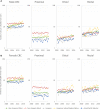Racial Disparities and Sex Differences in Early- and Late-Onset Colorectal Cancer Incidence, 2001-2018
- PMID: 34568072
- PMCID: PMC8459723
- DOI: 10.3389/fonc.2021.734998
Racial Disparities and Sex Differences in Early- and Late-Onset Colorectal Cancer Incidence, 2001-2018
Abstract
Background: Colorectal cancer (CRC) incidence rates have increased in younger individuals worldwide. We examined the most recent early- and late-onset CRC rates for the US.
Methods: Age-standardized incidence rates (ASIR, per 100,000) of CRC were calculated using the US Cancer Statistics Database's high-quality population-based cancer registry data from the entire US population. Results were cross-classified by age (20-49 [early-onset] and 50-74 years [late-onset]), race/ethnicity (non-Hispanic White, non-Hispanic Black, Hispanic, American Indian/Alaskan Native, Asian/Pacific Islander), sex, anatomic location (proximal, distal, rectal), and histology (adenocarcinoma, neuroendocrine).
Results: During 2001 through 2018, early-onset CRC rates significantly increased among American Indians/Alaskan Natives, Hispanics, and Whites. Compared to Whites, early-onset CRC rates are now 21% higher in American Indians/Alaskan Natives and 6% higher in Blacks. Rates of early-onset colorectal neuroendocrine tumors have increased in Whites, Blacks, and Hispanics; early-onset colorectal neuroendocrine tumor rates are 2-times higher in Blacks compared to Whites. Late-onset colorectal adenocarcinoma rates are decreasing, while late-onset colorectal neuroendocrine tumor rates are increasing, in all racial/ethnic groups. Late-onset CRC rates remain 29% higher in Blacks and 15% higher in American Indians/Alaskan Natives compared to Whites. Overall, CRC incidence was higher in men than women, but incidence of early-onset distal colon cancer was higher in women.
Conclusions: The early-onset CRC disparity between Blacks and Whites has decreased, due to increasing rates in Whites-rates in Blacks have remained stable. However, rates of colorectal neuroendocrine tumors are increasing in Blacks. Blacks and American Indians/Alaskan Natives have the highest rates of both early- and late-onset CRC.
Impact: Ongoing prevention efforts must ensure access to and uptake of CRC screening for Blacks and American Indians/Alaskan Natives.
Keywords: Epidemiology; National Program of Cancer Registries (NPCR); Surveillance; and End Results (SEER) program; early-onset colorectal cancer; joinpoint analysis; neuroendocrine tumors; racial disparities in cancer.
Copyright © 2021 Petrick, Barber, Warren Andersen, Florio, Palmer and Rosenberg.
Conflict of interest statement
The authors declare that the research was conducted in the absence of any commercial or financial relationships that could be construed as a potential conflict of interest.
Figures
Similar articles
-
Colorectal cancer incidence in the United States, 1999-2004 : an updated analysis of data from the National Program of Cancer Registries and the Surveillance, Epidemiology, and End Results Program.Cancer. 2009 May 1;115(9):1967-76. doi: 10.1002/cncr.24216. Cancer. 2009. PMID: 19235249
-
Increased risk for colorectal cancer under age 50 in racial and ethnic minorities living in the United States.Cancer Med. 2015 Dec;4(12):1863-70. doi: 10.1002/cam4.560. Epub 2015 Oct 16. Cancer Med. 2015. PMID: 26471963 Free PMC article.
-
United States colorectal cancer screening practices among American Indians/Alaska Natives, blacks, and non-Hispanic whites in the new millennium (2001 to 2010).Cancer. 2014 Oct 15;120(20):3192-299. doi: 10.1002/cncr.28855. Epub 2014 Aug 13. Cancer. 2014. PMID: 25123695
-
Prevalence and Incidence of Type 2 Diabetes and Prediabetes.In: Cowie CC, Casagrande SS, Menke A, Cissell MA, Eberhardt MS, Meigs JB, Gregg EW, Knowler WC, Barrett-Connor E, Becker DJ, Brancati FL, Boyko EJ, Herman WH, Howard BV, Narayan KMV, Rewers M, Fradkin JE, editors. Diabetes in America. 3rd edition. Bethesda (MD): National Institute of Diabetes and Digestive and Kidney Diseases (US); 2018 Aug. CHAPTER 3. In: Cowie CC, Casagrande SS, Menke A, Cissell MA, Eberhardt MS, Meigs JB, Gregg EW, Knowler WC, Barrett-Connor E, Becker DJ, Brancati FL, Boyko EJ, Herman WH, Howard BV, Narayan KMV, Rewers M, Fradkin JE, editors. Diabetes in America. 3rd edition. Bethesda (MD): National Institute of Diabetes and Digestive and Kidney Diseases (US); 2018 Aug. CHAPTER 3. PMID: 33651562 Free Books & Documents. Review.
-
Clinical and Genetic Factors to Inform Reducing Colorectal Cancer Disparitites in African Americans.Front Oncol. 2018 Nov 20;8:531. doi: 10.3389/fonc.2018.00531. eCollection 2018. Front Oncol. 2018. PMID: 30524961 Free PMC article. Review.
Cited by
-
Temporal Trends in Racial and Gender Disparities of Early Onset Colorectal Cancer in the United States: An Analysis of the CDC WONDER Database.J Gastrointest Cancer. 2024 Dec;55(4):1511-1519. doi: 10.1007/s12029-024-01096-6. Epub 2024 Oct 1. J Gastrointest Cancer. 2024. PMID: 39352432 Free PMC article. Review.
-
Molecular, Socioeconomic, and Clinical Factors Affecting Racial and Ethnic Disparities in Colorectal Cancer Survival.JAMA Oncol. 2024 Sep 12:e243666. doi: 10.1001/jamaoncol.2024.3666. Online ahead of print. JAMA Oncol. 2024. PMID: 39264607
-
Effect of an Inflatable Colon on Colorectal Cancer Knowledge and Screening Intent Among Male Attendees at State Fairs in Two Midwestern States, 2023.Prev Chronic Dis. 2024 Sep 5;21:E68. doi: 10.5888/pcd21.240020. Prev Chronic Dis. 2024. PMID: 39235979 Free PMC article.
-
Evolution of Colorectal Cancer Trends and Treatment Outcomes: A Comprehensive Retrospective Analysis (2019-2023) in West Kazakhstan.Asian Pac J Cancer Prev. 2024 Aug 1;25(8):2773-2785. doi: 10.31557/APJCP.2024.25.8.2773. Asian Pac J Cancer Prev. 2024. PMID: 39205575 Free PMC article.
-
Clinical and pathological characteristics of and predictive model for colorectal neuroendocrine tumors.Heliyon. 2024 Aug 2;10(15):e35720. doi: 10.1016/j.heliyon.2024.e35720. eCollection 2024 Aug 15. Heliyon. 2024. PMID: 39170272 Free PMC article.
References
-
- American Cancer Society . Colorectal Cancer Facts & Figures 2020-2022. Atlanta: American Cancer Society; (2020). Available at: https://www.cancer.org/content/dam/cancer-org/research/cancer-facts-and-....
-
- Meester RGS, Peterse EFP, Knudsen AB, de Weerdt AC, Chen JC, Lietz AP, et al. . Optimizing Colorectal Cancer Screening by Race and Sex: Microsimulation Analysis II to Inform the American Cancer Society Colorectal Cancer Screening Guideline. Cancer (2018) 124(14):2974–85. 10.1002/cncr.31542 - DOI - PMC - PubMed
LinkOut - more resources
Full Text Sources



